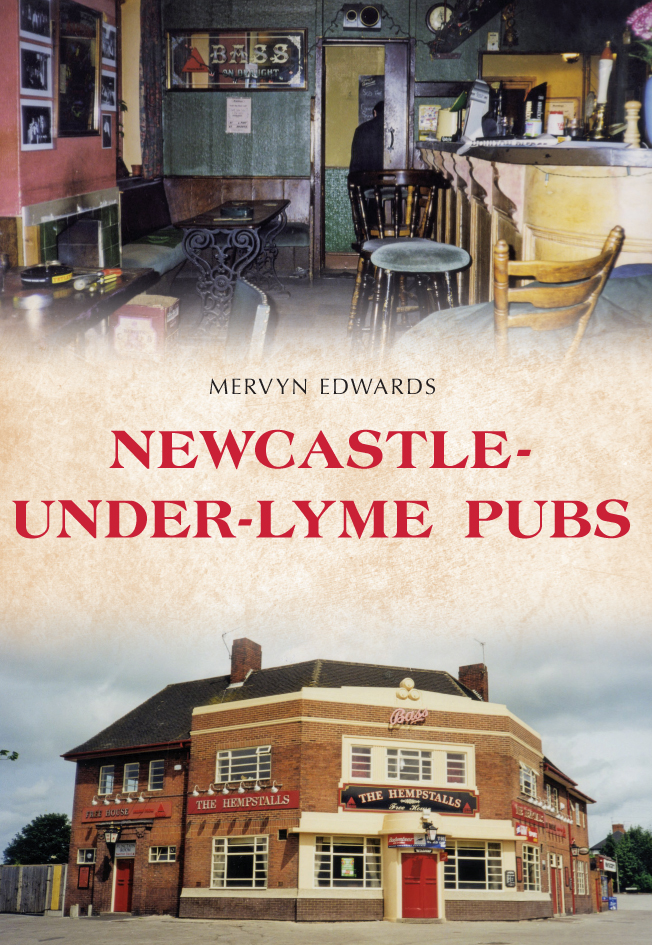Newcastle-under-Lyme Pubs by Mervyn Edwards
Newcastle-under-Lyme Pubs has recently hit the bookshelves. It is my eighteenth published book, my ninth title for Amberley.
It occurs to me that the nature of a historian’s remit and his duty to view the past objectively and sometimes dispassionately may not always benefit either him or his readers.
The thought struck me when I was writing the introduction to my book – and peppering what was intended as a brief historical overview with a few opinions and observations based on thirty-five years of socialising in Newcastle hostelries. Such an exercise probably did my mental health a power of good, whilst offering readers a few interesting perspectives to chew on.
However, there was no real danger of my book lapsing into a nostalgia fest. With a production such as this, the reader will generate his or her own nostalgia in any case, cooing over the photographs and shedding a tear over long-lost, much-loved pubs.
For me, it was a matter of particular interest to show how history insists on repeating itself. How the pubs that have survived have gone through cycles of good trade and bad, often dictated by the competence of licensees. How reputations have waxed and waned and how the strategies and advertising blurb of marketing men have been exposed very quickly as gimcrack manoeuvres likely to bring only short-term gain.
In such circumstances, the conscientious historian sometimes genuflects to the slightly piqued social commentator, lamenting ill-advised and sometimes fatuous changes to the pubs we have loved. The recorder of history stands aloof, viewing these changes in wider context. Other knowledgeable observers, free from such constraints, rage against the machine that brings these changes, destroying our heritage and spitting on our memories.
The chapter in my book featuring the Rigger pub in Marsh Parade, Newcastle, is a great story seen in terms of why it was opened in 1963 – as the Bandstand – and how this totally landlocked pub adopted a nautical theme, complete with ropes, sails and other maritime bric-a-brac in 1970. The pub has long since found its feet as a music venue, and at this chronological distance, the attempt to give it a seafaring image seems risible. However, other pubs have known radical changes over the years, too, notably the Old Bull’s Head in Lad Lane, which embraced the fad for ersatz Irish pubs in the 1990s. Traditionalists battled vigorously against Allied Domecq’s plans – to no avail. All we had left was the sure-fire certainty that the vogue for Irish theme pubs would soon fade and that normal service would be resumed. It duly did, although the about-turn was sharp and jarring. The pub re-opened, bereft of fake shamrocks and harps but now sporting murals depicting old Newcastle: Queen’s Gardens, Holy Trinity Church and other landmarks. If this was a sop intended to placate traditionalists still hurting over the mock-Irish dalliance, it didn’t work. Perhaps it was seen by some as manipulative, even patronising. The pub’s present interior is as most people would remember it from years ago: plain, dimly-lit, cosy and genuinely characterful.
Some of the more popular pubs in Newcastle have been nurtured over time and have grown slowly and organically. They may have their faults, but there’s integrity about them. Think of the Museum or the George and Dragon. However, it is interesting to consider how some pubs and bars that opened in the last twenty years or so didn’t stand the test of time. One venue in Hassell Street has been re-named several times since it re-opened under the name of the Farrow and Firkin in 1994. So why didn’t it last? Was it the silly name, or were the splintered wooden tables and rustic décor to blame? Who knows? What is for certain is that fashions go in and out like the tide, and the minimalist “alehouse” style interior is once again a la mode at the time of writing. Gatsby’s bar in Ironmarket was another that failed – despite its innovative interior design, complete with blood red upholstering and classy chrome fittings.
Newcastle-under-Lyme Pubs charts many of these changes, sometimes with a degree of sadness, but always with a view to explaining why it was that history took certain turns. What were the reasons that led to the opening of the Borough Arms Hotel in the 1850s? How did the Museum get its name? Why on earth did the age-old Star in Ironmarket become known as the Superstar? All is revealed in the book.
Mervyn Edwards new book Newcastle-under-Lyme Pubs is available for purchase now.



